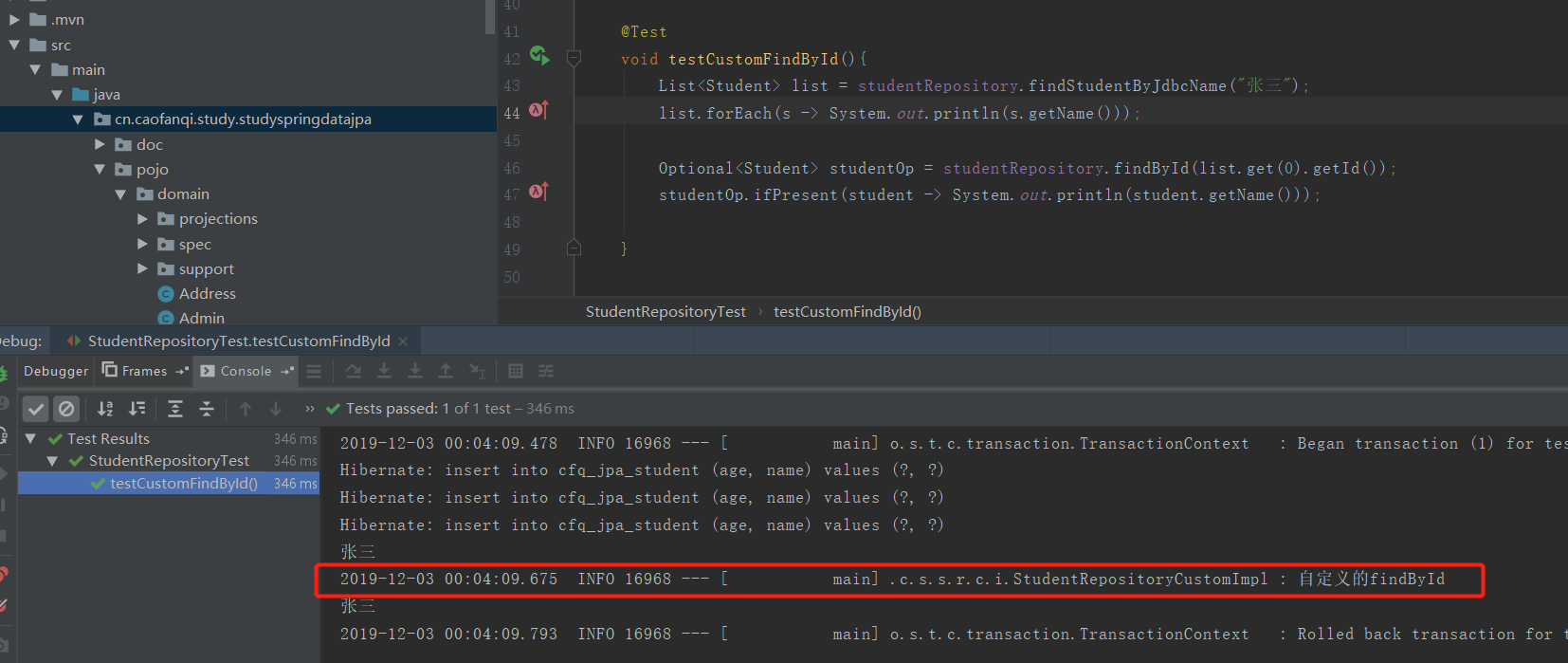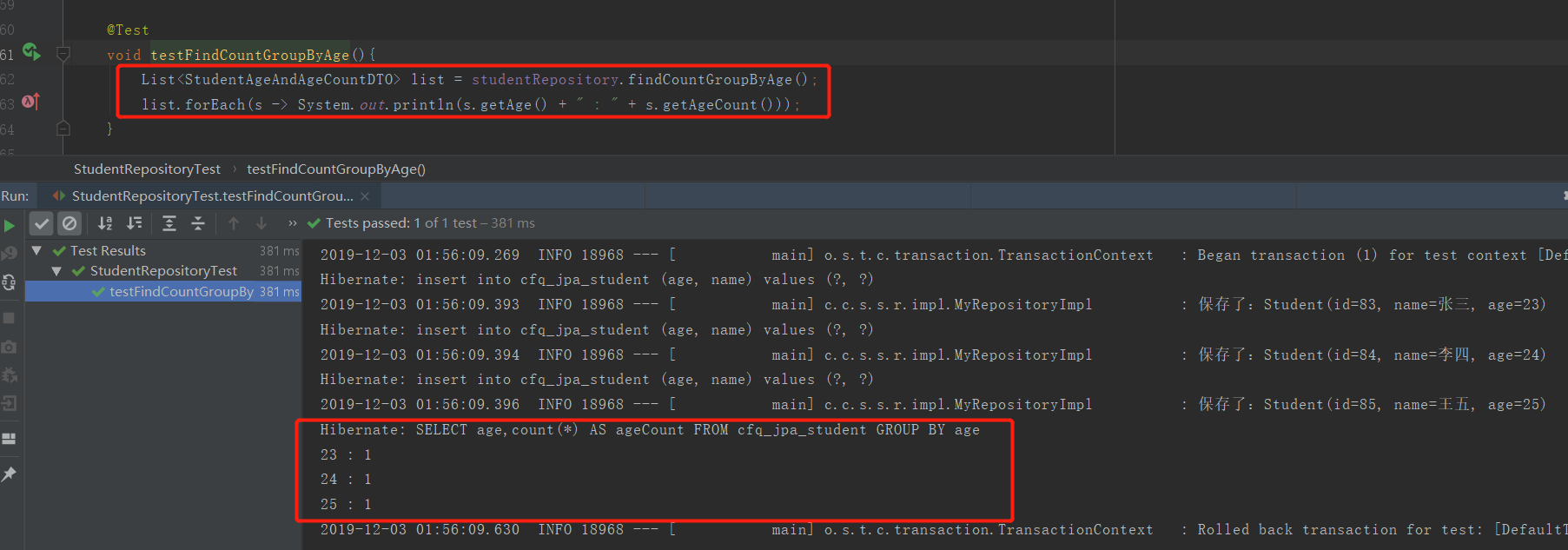有些时候,我们需要自定义Repository实现一些特殊的业务场景。
1、自定义单个Repository
1.1、首先提供一个片段接口和实现(接口的实现默认要使用Impl为后缀,实现本身不依赖spring-data,可以是常规的spring-bean,所以可以注入其他的bean,例如JdbcTemplate)。
/** * @author caofanqi */ public interface StudentRepositoryCustomJdbc { List<Student> findStudentByJdbcName(String name); } /** * 默认要以Impl结尾 * @author caofanqi */ public class StudentRepositoryCustomJdbcImpl implements StudentRepositoryCustomJdbc { @Resource private JdbcTemplate jdbcTemplate; @Override public List<Student> findStudentByJdbcName(String name) { String sql = "SELECT * FROM cfq_jpa_student WHERE name = " + "'" + name + "'"; return jdbcTemplate.query(sql, BeanPropertyRowMapper.newInstance(Student.class)); } }
1.2、自己的Repository继承自定义接口,就可以使用拓展的功能了。
/** * 继承jpa的repository,和自己自定义的扩展 * @author caofanqi */ public interface StudentRepository extends JpaRepositoryImplementation<Student,Long>, StudentRepositoryCustomJdbc { }
1.3、测试如下:
@BeforeEach void setup(){ Student s1 = Student.builder().name("张三").age(23).build(); Student s2 = Student.builder().name("李四").age(24).build(); Student s3 = Student.builder().name("王五").age(25).build(); studentRepository.saveAll(Lists.newArrayList(s1,s2,s3)); } @Test void testFindStudentByJdbcName(){ List<Student> list = studentRepository.findStudentByJdbcName("张三"); list.forEach(s -> System.out.println(s.getName())); }
1.4、控制台打印:
Hibernate: insert into cfq_jpa_student (age, name) values (?, ?) Hibernate: insert into cfq_jpa_student (age, name) values (?, ?) Hibernate: insert into cfq_jpa_student (age, name) values (?, ?) 张三
1.5、自定义扩展可以有多个。自定义的优先级高于spring-data为我们提供的。
/** * 继承jpa的repository,和自己自定义的扩展 * @author caofanqi */ public interface StudentRepository extends JpaRepositoryImplementation<Student,Long>, StudentRepositoryCustomJdbc,StudentRepositoryCustom<Student,Long> { }
/** * 自定义student功能 * * @author caofanqi */ public interface StudentRepositoryCustom<T,ID> { Optional<T> findById(ID id); } /** * 自定义实现repository功能 * * @author caofnqi */ @Slf4j public class StudentRepositoryCustomImpl<T,ID> implements StudentRepositoryCustom<T,ID> { @PersistenceContext private EntityManager entityManager; @Override public Optional<T> findById(ID id) { log.info("自定义的findById"); T t = (T) entityManager.find(Student.class, id); return Optional.of(t); } }

1.6、可以通过@EnableJpaRepositories的repositoryImplementationPostfix属性自定义后缀,默认是Impl。
/** * 启动类 * @author caofanqi */ @SpringBootApplication @EnableAsync @EnableJpaRepositories(repositoryImplementationPostfix = "MyPostfix") public class StudySpringDataJpaApplication { public static void main(String[] args) { SpringApplication.run(StudySpringDataJpaApplication.class, args); } }
2、自定义BaseRepository
2.1、SpringDataJpa为我们提供的代理类其实是SimpleJpaRepository。

2.2、如果我们想要对所有的Repository的保存操作都进行记录日志,我们可以自定义BaseRepository,来充当代理类。(还可以是逻辑删除等场景)
2.2.1、自定义baseRepository
/** * 自定义base Repository * * @author caofanqi */ @Slf4j public class MyRepositoryImpl<T,ID> extends SimpleJpaRepository<T,ID> { private final EntityManager entityManager; MyRepositoryImpl(JpaEntityInformation entityInformation, EntityManager entityManager) { super(entityInformation, entityManager); this.entityManager = entityManager; } @Override public <S extends T> S save(S entity) { S save = super.save(entity); log.info("保存了:{}",save); return save; } }
2.2.2、告知Spring-Data-Jpa使用我们自定义的baseRepository
/** * 启动类 * @author caofanqi */ @SpringBootApplication @EnableAsync @EnableJpaRepositories( /*queryLookupStrategy = QueryLookupStrategy.Key.CREATE_IF_NOT_FOUND*/ /* ,repositoryImplementationPostfix = "MyPostfix",*/ repositoryBaseClass = MyRepositoryImpl.class) public class StudySpringDataJpaApplication { public static void main(String[] args) { SpringApplication.run(StudySpringDataJpaApplication.class, args); } }
2.2.3、再次测试testSave方法,如下

3、entityManager执行原生复杂sql返回DTO
使用方法派生查询和@Query注解查询时,我们可以使用投影来面向对象编程,但是使用entityManager执行原生sql复杂sql时,怎么返回实体呢?如下:
3.1、DTO
/** * entityManager使用的结果映射,需要一个无参构造函数与set方法,这一点与投影不一样 * @author caofanqi */ @Data @NoArgsConstructor @AllArgsConstructor public class StudentAgeAndAgeCountDTO { private Integer age; private Long ageCount; }
3.2、查询方法
public List<StudentAgeAndAgeCountDTO> findCountGroupByAge(){ /* *sql可以是更复杂的 */ String sql = "SELECT age,count(*) AS ageCount FROM cfq_jpa_student GROUP BY age "; Query nativeQuery = entityManager.createNativeQuery(sql); nativeQuery.unwrap(NativeQuery.class) //设置类型 .addScalar("age", StandardBasicTypes.INTEGER) .addScalar("ageCount",StandardBasicTypes.LONG) //设置返回bean .setResultTransformer(Transformers.aliasToBean(StudentAgeAndAgeCountDTO.class)); return nativeQuery.getResultList(); }
3.3、测试及结果

源码地址:https://github.com/caofanqi/study-spring-data-jpa